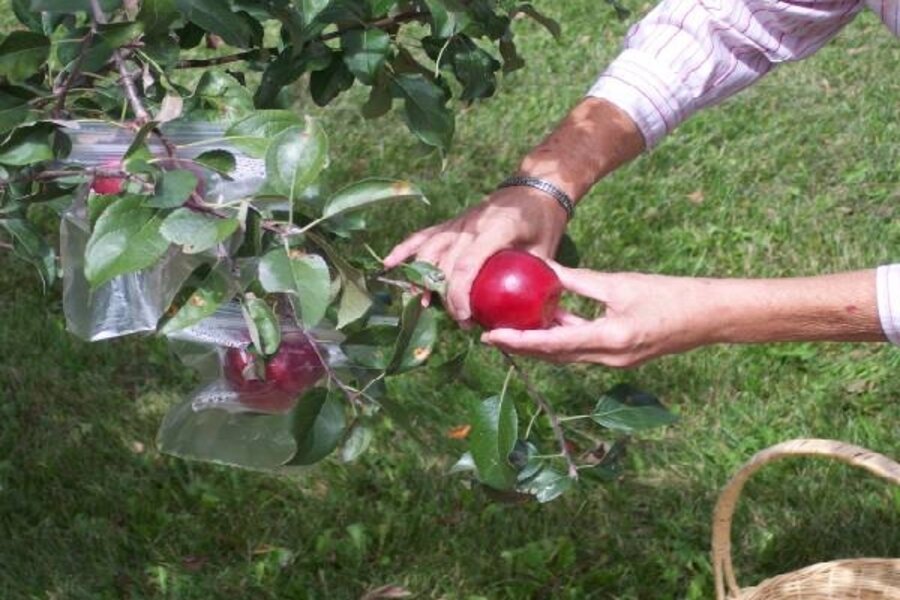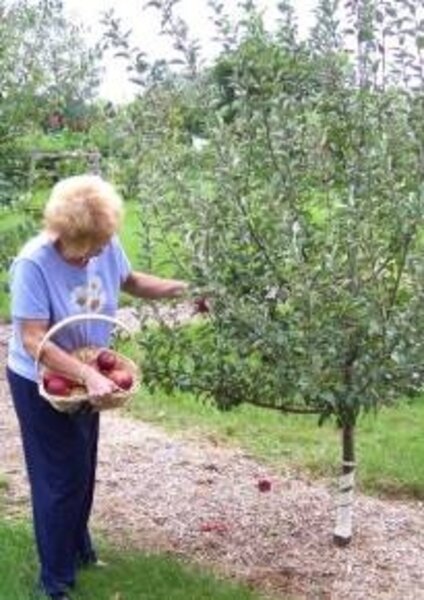How to pick an apple
Loading...
Lift the apple upward, at about 180 degrees, and if the stem starts to separate from the tree, the apple is ready to pick. That’s the easy part.
Picking the right apple to grow is more complicated. Climate, rootstock, and how much effort you want to expend determine which varieties you should plant. I was bewildered.
Then, I subscribed to the North American Fruit Explorer’s (NAFEX) listserv and started learning from the wisest of fruit gurus. These are men and women who have made the mistakes and learned from them, university researchers, and plant breeders.
Size, I quickly learned, matters greatly. Dwarf trees obviously are the best for suburban gardens and hobby growers like me. You don’t have to stand on a ladder to prune or pick.
But, not all dwarfs are the same. Depending on the rootstock to which an apple variety is grafted, a mature dwarf tree can run from four feet to 20 feet tall.
Look for rootstock information on tree tags at garden centers, in catalogs, or on nursery websites.
Dwarf apple trees are created by grafting a short length of new growth (called a scion) from a healthy tree to a small, fully rooted tree with desirable characteristics such as early fruiting or tolerance to wet soil. The rootstock trunk is cut off a couple of inches above ground, and the scion is grafted at the cut. The resulting tree is grown in the ground or in a nursery can a full season before the tree is offered for sale.
Dwarf Apple Rootstocks (produces tree of the height listed below)
M27: 4 to 8 feet, well suited for containers and urban gardens, Zones 5-9.
Bud 9: 6 to 10 feet, very cold hardy, Zones 3-5.
M9: 8 to 10 feet, tolerant of wet soils, Zones 5-8.
M26: 10 to 14 feet, very cold hardy, Zones 3-5.
M111: 15 to 20 feet, drought tolerant, Zones 4-8.
After I figured out that trees on Bud 9 rootstock were best for my frigid climate, I faced choosing the best tasting apple or two. I wanted a sweet apple, one that was juicy and crisp. In other word, Honey Crisp! Luckily, it’s bred for my climate, and I planted it first.
Next, I wanted the same qualities, but with a little less juice and more nuanced flavor. Ed Fackler, who worked with Purdue University in developing disease-resistant apples for home gardens, recommended Pixie Crunch, an improvement of Rome. It’s a small red, crisp jewel and a good keeper.
In the next two years, I added five additional apple varieties to my garden. As my fruit education thanks to NAFEX grew, I became more discerning in my choices. The mini-orchard of nine-foot trees includes Ashmead’s Kernel, Pitsmaston Pineapple, Cox’s Orange Pippin, Sops of Wine and Golden Delicious, besides the original two.
I’ll be out in the orchard picking apples for the next month, to share with friends, give to the Plant a Row for the Hungry food pantry and store for fresh eating all winter. I’ll be baking pies, strudel, and crisps, too. Yum! I can hardly wait.
If it’s edible and unusual, Doreen Howard figures out a way to grow it in her USDA Zone 4b garden. She’ll try anything once, even smelly Durian. A former garden editor at Woman’s Day, she writes regularly for The American Gardener and The Old Farmer’s Almanac’s Garden Guide.
Editor’s note: Look for more blog posts by The Edible Explorer, Doreen Howard, at our blog archive. For more Monitor gardening, see our main gardening page and our RSS feed.
You may also want to visit Gardening With the Monitor on Flickr. Take part in the discussions and get answers to your gardening questions. If you join the group (it’s free), you can upload your garden photos and enter our next contest. We’ll be looking for photographs of fruits. So find your best shots of summer’s blueberries, peaches, plums, etc., and get out your camera to take some stunning shots of early fall apples. Post them before Sept. 30, 2009, and you could be the next winner.






